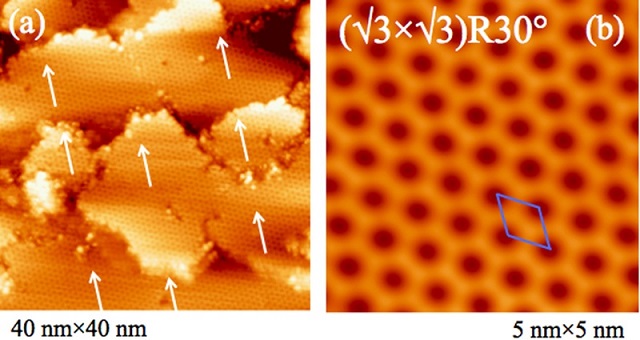
(a) Filled-states STM topograph giving a bird’s eye view of a multilayer silicene film covering the entire scanned area in a single orientation, as indicated by the arrows; (b) zoom-in showing the honeycomb surface structure of each terrace. Image courtesy: IOP Publishing
2D Materials, a journal of IOP Publishing, has published a study demonstrating the stability of silicene when exposed to oxygen. The two-dimensional material is able to maintain its stability for at least 24 hours.
A research team consisting of scientists based in France and Italy produced silicene multilayers from a solid silicon source that was heated at a temperature of 1470K. The fabrication involved deposition of a total of 43 silicene monolayers on a silver substrate that was maintained at 470K. Subsequent to the fabrication of the silicene multilayers, the team observed the formation of a very thin oxidation layer over the multi-layered stack of silicene monolayers.
The researchers demonstrated that this oxidation layer serves as a protective layer to maintain the integrity of the multi-layered stack, preserving the stack of monolayers for at least 24 hours in the presence of oxygen.
This time was sufficient for the research team to corroborate the identity of the material using Raman spectroscopy and X-ray diffraction. The study results would help in gaining new insights into the fundamental properties of the one-atom-thick material that have made it a potential candidate for electronic applications.
These results are significant as we have shown that it is possible to obtain a silicon-based 2D material, which up until a couple of years ago was deemed inconceivable.
Paola De Padova - Lead Author, Consiglio Nazionale delle Ricerche
According to lead author, Paola De Padova, the results demonstrated the possibility of fabricating a silicon-based 2D material, which was earlier considered impossible. He continued that the results also proved the higher conductivity of the multi-layered silicene when compared to single-layered silicene, showing its potential application in the silicon microelectronics industry. At present, the research team is exploring how to directly grow multi-layered silicene on semiconductor substrates in order to study the joint superconducting properties, he added.
This new discovery comes only days after IOP published a report on human anxiety drugs finding their way through wastewater into fresh water have actually been shown to reduce mortality rates in fish.